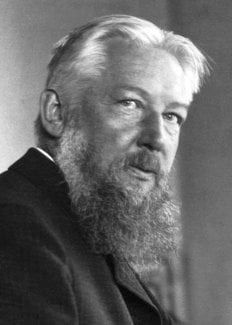Wilhelm Ostwald
Biographical

Wilhelm Ostwald was born on September 2, 1853, in Riga, Latvia, as the son of master-cooper Gottfried Wilhelm Ostwald and Elisabith Leuckel.
He was educated at the “Real gymnasium” there and in 1872 was admitted to Dorpat University to read chemistry. After taking his final examinations three years later, he obtained the post of assistant at the Physics Institute under Professor Arthur von Oettingen, and subsequently took a similar position in the Chemistry Laboratory under Carl Schmidt. Ostwald himself declared that he was most indebted to these two teachers for his scientific training. In 1877 he was admitted as unpaid academic lecturer at Dorpat University, and this was followed (1881) by the appointment of full time Professor of Chemistry at the Polytechnicum in Riga. Six years later he accepted an invitation as Professor of Physical Chemistry at Leipzig University. Among his later famous pupils are Arrhenius (Nobel Prize 1903), Van ‘t Hoff (Nobel Prize 1901), Nernst (Nobel Prize 1920), Tammann and Wislicenus. Ostwald remained in Leipzig until he retired in 1906, with the short interruption for one term as first “Exchange Professor” at Harvard University, Cambridge (Mass.) in 1904-1905.
Ostwald started his experimental work in 1875, with an investigation on the law of mass action of water in relation to the problems of chemical affinity, with special emphasis on electrochemistry and chemical dynamics.
In consequence of his pioneering work especially in the field of electrochemistry, which also led to the discovery of the law of dilution named after him, his activities as a writer and his gift for organization, Ostwald became one of the founders of classical physical chemistry. He published numerous textbooks, starting with the Lehrbuch der Allgemeinen Chemie (Textbook of general chemistry) in 1884. This was followed by Grundriss der Allgemeinen Chemie (Outline of general chemistry) in 1889 and Hand- und Hilfsbuch zur Ausführung physikalisch-chemischer Messungen (Handbook and manual for physicochemical measurements) in 1893. Numerous other scientific works on analytical chemistry, electrochemistry, inorganic chemistry followed.
Ostwald also founded and edited the Zeitschrift für physikalische Chemie in 1887; Ostwald himself edited 100 volumes, up to 1922.
He was also in charge of the organization of the Department of Physical Chemistry at Leipzig University, and in 1894 he founded the “Deutsche Elektrochemische Gesellschaft” (German Electrochemical Society) which in 1902 expanded to become the “Deutsche Bunsen-Gesellschaft für angewandte physikalische Chemie” (German Bunsen-Society for Applied Physical Chemistry).
In 1909 Ostwald was awarded the Nobel Prize for Chemistry for his work on catalysis, chemical equilibria and reaction velocities. He received honorary doctorates from several universities in Germany, Great Britain and the USA, and was made an honorary member of learned societies in Germany, Sweden, Norway, the Netherlands, Russia, Great Britain and the USA. In 1899 he was made a “Geheimrat ” by the King of Saxony.
After his retirement in 1906, Ostwald found a new sphere for his scientific and organizatorial talents. Besides continuing his studies and publication on philosophy, such as Der energetische Imperativ (The energetic imperative), Moderne Naturphilosophie (Modern natural philosophy), Die Pyramide der Wissenschaften (The pyramid of the sciences), he also took an active part in public life. He supported the middle-class pacifist movement, was interested in educational reforms and in monism. He believed that in view of his position he could decisively fight the Church’s claim to power in the field of natural sciences and to spread a modern scientific ideology. This aim he pursued in his writings Monistische Sonntagspredigten (Monistic Sunday sermons) and Arbeiten zum Monismus (Works on monism).
In 1902 Ostwald founded Annalen der Naturphilosophie and edited 14 volumes up to 1921. He also founded Klassiker der exakten Wissenschaften in 1889, of which some 250 volumes have been published.
Right up to the end of his life Ostwald studied colours and shapes, in the endeavour to find a scientific standardization for colours. His main works in this field are Die Farbenfibel (The coulour primer), Die Farbenlehre (Colour theory), Die Harmonie der Farben (Harmony of the colours). He also published a periodical Die Farbe (Colour).
Ostwald was married to Helene von Reyher in 1880. They had two daughters and three sons, one of whom, Dr. Karl Wilhelm Wolfgang (known in the scientific literature as Wo. Ostwald), was Lecturer in the University of Leipzig, and Editor of the Zeitschrift für Chemie und Industrie der Kolloide, the forerunner of the Kolloid-Zeitschrift.
After an extremely active life, Ostwald died at his country home near Leipzig on April 4, 1932.
This autobiography/biography was written at the time of the award and first published in the book series Les Prix Nobel. It was later edited and republished in Nobel Lectures. To cite this document, always state the source as shown above.
The Nobel Foundation's copyright has expired.Nobel Prizes and laureates
Six prizes were awarded for achievements that have conferred the greatest benefit to humankind. The 14 laureates' work and discoveries range from quantum tunnelling to promoting democratic rights.
See them all presented here.
